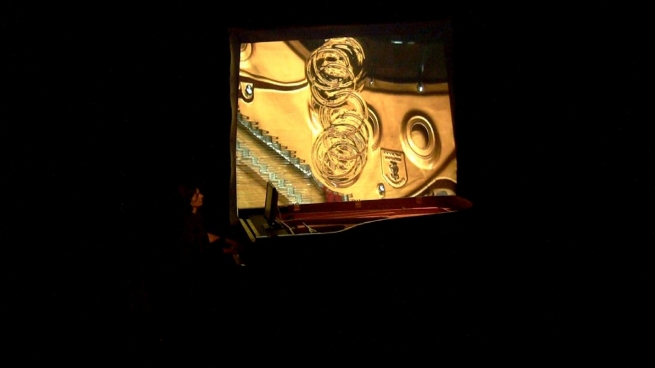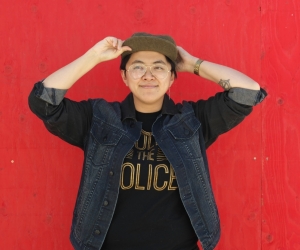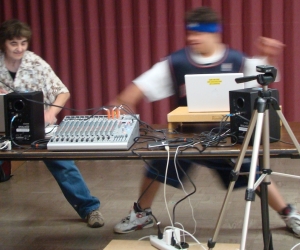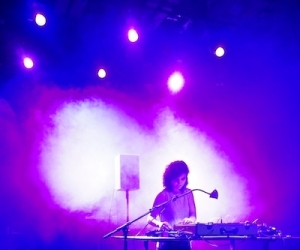
Surface Tension is a thirty-five-minute collaborative interarts work that the two of us (pianist Eve Egoyan and installation artist David Rokeby) created for Disklavier piano and interactive video. The piece explores the relationship between what we do separately in our respective creative practises. It is an exploration of possibility, of ways to integrate our two very different approaches to creating meaning. We used the substantial tensions between our approaches and practices as an important generative engine in the development of the work.
While surface tension refers most directly to the membrane-like quality of the boundary that separates inside and outside, we were attracted to the idea from the perspective of touch: the phenomena that manifest themselves, as this delicate boundary comes into delicate contact with other things (with implicit reference to Eve’s fingers touching the piano). But there is another kind of touch and another kind of tension active here—the contact and tension between our two creative worlds, and an explicit acknowledgement of the delicacy required in bringing these worlds into productive relationship.
In Surface Tension, Egoyan’s performance at the keyboard of a Disklavier (an acoustic piano with a computer interface) is transformed and interpreted by a computer into live visual images projected onto a screen jutting up from the body of the piano. The visual images are modulated by computer response to a variety of performance parameters, including dynamics, pitch, the harmonic relation between pitches, the use of the sustain pedal, and the duration of individual notes. This transforms the piano into a visual instrument as well as a musical one. Rokeby has based much of the visual material on simulations of natural processes such as the swarming behaviours of insects, the trajectories of planets, or the rippling of water when hit by a pebble. Egoyan’s performance triggers and modulates aspects of these simulations, but the visual representations also have a life of their own, becoming in a sense a partner in the performance.
The performance itself is a loosely structured audio-visual improvisation in five movements. In one of the movements, each note played on the piano contributes to the construction of a three-dimensional tower. In another, Eve draws out the trajectories of falling snowflakes, manipulating the live processing of a pre-recorded video. Yet another movement charts the harmonic relationships between the notes that Egoyan is playing. The improvisation is shaped partly by Egoyan’s response to the system’s visual response to her playing, and all visual activity on the screen is directly responsive to Egoyan’s playing. The result is an extraordinary integration of sound and image in which neither of these elements dominate the other.
UPDATE: Eve Egoyan and David Rokeby present the Toronto premiere of Surface Tension at the Royal Conservatory of Music's inaugural 21C Music Festival. The performance is part of the program entitled "21C: chilly eve of lemon cane" (8 p.m., Friday May 23, Koerner Hall; pre-concert talk at 7:15 p.m.)
Audio: Surface Tension (Excerpt, 2009). Composed by Eve Egoyan. Performed by Eve Egoyan, Yamaha Disklavier; interactive computer-modulated video. Image: by Stefan Rose.


